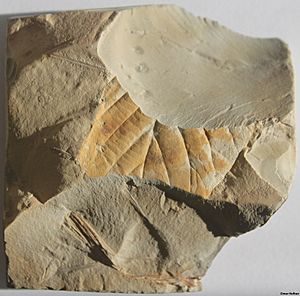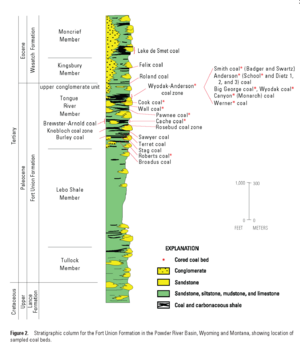Fort Union Formation facts for kids
Quick facts for kids Fort Union FormationStratigraphic range: Maastrichtian-Selandian (Lancian-Clarkforkian) ~66–58Ma |
|
|---|---|

Fossils from the Fort Union Formation
|
|
| Type | Geological formation |
| Sub-units | Atwell Gulch, China Butte, Ekalaka, Lebo, lower Ludlow, Overland, Rock Bench Quarry, Sentinel Butte, Shotgun, Somber beds, Tongue River, Tullock, upper Ludlow, Polecat Bench Formation |
| Underlies | Wasatch Formation |
| Overlies | Hell Creek Formation, Lance Formation |
| Lithology | |
| Primary | Sandstone, shale |
| Other | Coal |
| Location | |
| Region | Montana, North Dakota Wyoming, Colorado |
| Country | |
| Extent | Powder River Basin |
The Fort Union Formation is a huge set of rock layers found in parts of Wyoming, Montana, and nearby states in the United States. These rocks are made up of different materials like sandstone, shale, and many layers of coal. This formation is very important because it holds valuable resources such as coal, uranium, and coalbed methane gas, especially in an area called the Powder River Basin.
What is the Fort Union Formation?
Most of the Fort Union Formation rocks formed during a time called the Paleocene Epoch. This was about 66 to 56 million years ago. During this time, the area was covered by huge swamps, rivers (called fluvial conditions), and lakes (called lacustrine conditions).
The types of rocks found in the Fort Union Formation change depending on the location. In southwestern Wyoming, the rocks are mostly sandy. In northeast Wyoming and southeast Montana, there is much more coal. This shows how the environment changed from rivers and lakes in the west to swamps in the east. However, all three environments were present at different times in most places.
Coal Deposits
The Fort Union Formation is famous for its large amounts of coal. In the Powder River Basin, most of this coal is found in a part of the formation called the Tongue River Member. Here, there can be as many as 32 different layers of coal. These layers can add up to more than 300 feet (about 91 meters) in total thickness!
One amazing example is the Wyodak Coal bed, located near Gillette, Wyoming. This single coal layer can be as thick as 110 feet (about 33.5 meters). Most of the coal in the Fort Union Formation is a type called subbituminous coal. This means it is a softer type of coal, often used to generate electricity.
Ancient Life in the Fort Union Formation
Scientists have found interesting fossils in the Fort Union Formation. One important discovery was a piece of a bone from an ancient bird. This bone, called a coracoid, is from a type of bird known as an ornithurine.
What makes this fossil special is that it looks exactly like bones found in the older Hell Creek Formation. The Hell Creek Formation is famous for its dinosaur fossils and ends right at the time of the Cretaceous–Paleogene extinction event. This was the giant event that wiped out most of the dinosaurs and many other living things about 66 million years ago.
This unnamed bird species is currently the only known bird that survived this huge extinction event. It shows that some life forms were able to make it through that difficult time.


